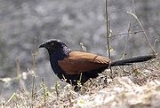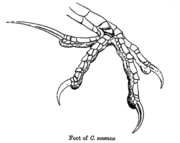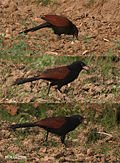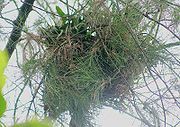
Greater Coucal
Encyclopedia
The Greater Coucal or Crow Pheasant (Centropus sinensis) is a large non-parasitic member of the cuckoo
order
of bird
s, the Cuculiformes. A widespread resident in Asia
, from India
, east to south China
and Indonesia
, it is divided into several subspecies
, some being treated as full species
. They are large, crow-like with a long tail and coppery brown wings and found in wide range of habitats from jungle to cultivation and urban gardens. They are weak fliers, and are often seen clambering about in vegetation or walking on the ground as they forage for insects, eggs and nestlings of other birds. They have a familiar deep resonant call which is associated with omen
s in many parts of its range.
_in_kolkata_i_img_3240.jpg) This is a large species
This is a large species
of cuckoo at 48 cm. The head is black, upper mantle and underside are black glossed with purple. The back and wings are chestnut brown. There are no pale shaft streaks on the coverts. The eyes are ruby red. Juveniles are duller black with spots on the crown and there are whitish bars on the underside and tail. There are several geographic races and some of these populations are sometimes treated as full species. Earlier treatments included the Brown Coucal
(C. (s.) andamanensis) under this name. Rasmussen & Anderton (2005) suggest that the race parroti may be a full species - the Southern Coucal which is fround in peninsular India (northern boundary unclear). The race intermedius of the Assam and Bangladesh region is smaller than the nominate race found in the sub-Himalayan zone. Songs of the races are said to vary considerably. Race parroti of southern India has a black head and the underparts glossed blue and has the forehead, face and throat more brownish. The sexes are similar in plumage but females are slightly larger.
Leucicistic specimens have been observed.
 The nominate race is found from the Indus Valley through the sub-Himalayan and Gangetic plains to Nepal, Assam and the Bhutan foothills into southern China (Guangxi, Zhejiang, Fujian).
The nominate race is found from the Indus Valley through the sub-Himalayan and Gangetic plains to Nepal, Assam and the Bhutan foothills into southern China (Guangxi, Zhejiang, Fujian).
_-_immature_at_hodal_iws_img_1207.jpg) The young when hatched have black skin and white hairy feathers (termed as trichoptiles) forming a fringe over the eye and beak. The centre of the belly is pinkish and the upper mandible is black with a pink edge. The iris is brown, gape
The young when hatched have black skin and white hairy feathers (termed as trichoptiles) forming a fringe over the eye and beak. The centre of the belly is pinkish and the upper mandible is black with a pink edge. The iris is brown, gape
yellow and feet dark brown-gray.
The juvenile of race parroti is unmarked dull black on the underside (contra barred in the northern races) and much darker, dusky chestnut on the wings. Race bubutus found in Southeast Asia has a distinct call. Individuals from the Western Ghats
are very similar in size to the Lesser Coucal
Centropus bengalensis but the latter has a stubbier bill, shorter tail, wing tips extending beyond the tertials and a chestnut wing lining, dark eyes and a tail with green/bronze sheen. Females of the race parroti develop dusky or sooty wing coverts between November and January and the northern boundary of the race is along the Punjab plains where it forms intermediates with the northern forms.
 The Greater Coucal is a large bird which takes a wide range of insect
The Greater Coucal is a large bird which takes a wide range of insect
s, caterpillar
s and small vertebrate
s such as the Saw-scaled vipers. They are also known to eat bird eggs, nestlings, fruits and seeds. In Tamil Nadu they were found to feed predominantly on snails Helix vittata. They are also known to feed on the toxic fruits of Thevetia peruviana
(Yellow Oleander). In Oil palm
cultivation, they have been noted as an avian pest due to their habit of eating the fleshy mesocarps of the ripe fruits.
-_drying__sunning_after_rains_in_kolkata_i_img_9091.jpg) They sunbathe in the mornings singly or in pairs on the top of vegetation with their wings spread out. The territory of a nesting pair has been found in southern India to be 0.9 to 7.2 ha (mean 3.8 ha). They are most active in the warm hours of the morning and in the late afternoon.
They sunbathe in the mornings singly or in pairs on the top of vegetation with their wings spread out. The territory of a nesting pair has been found in southern India to be 0.9 to 7.2 ha (mean 3.8 ha). They are most active in the warm hours of the morning and in the late afternoon.
The calls are a booming low coop-coop-coops repeated and with variations and some duets between individuals. When duetting the female has a lower pitched call. Other calls include a rapid rattling "lotok, lotok ..." and a harsh scolding "skeeaaaw" and a hissing threat call.
 The breeding season is after the monsoon
The breeding season is after the monsoon
in southern India but varies in other parts of its range but chiefly June to September.
Greater Coucals are monogamous, and the courtship display involves chases on the ground and the male brings food gifts for the female. The female lowers her tail and droops her wings to signal acceptance. The nest is built mostly by the male over about three to eight days. The nest is a deep cup with a dome in dense vegetation inside tangles of creepers, bamboo clump or Pandanus crowns. They can be built as high as 6m above the ground and the typical clutch is 3-5 egg
s. The eggs (of size 36–28 mm weighing 14.8 g ) are chalky white with a yellow glaze when laid that wears off. Both the male and the female take part in nest building. They lay 2 to 4 eggs that hatch after 15–16 days of incubation. The chicks take 18–22 days to fledge. A study in southern India found that 77% of the eggs hatched and 67% fledged. Nests with eggs were sometimes abandoned or marauded by the Jungle Crow Corvus macrorhynchos.
Haemosporidia closely related to those that cause malaria have been found in their red blood cells. One species, Haemoproteus centropi, is described from Cuckoos such as Clamator jacobinus and Centropus sinensis and is spread by mosquitoes. Immature Haemaphysalis ticks have been found feeding on Greater Coucals.
In British India, it was noted that new-recruits to India often mistook it for a pheasant and shot it to find it "evil flavoured" giving it the nickname of "Griff's pheasant".
Local names include Mahoka in Hindi; Punjabi: Kamadi kukkar; Bengali: Kubo Assamese: Kukoo sorai, Kukuha sorai, Dabahi kukuha; Cachar: Dao di dai; Manipuri: Nongkoubi; Gujarati: Hokko, Ghoyaro, Ghumkiyo; Kutch: Hooka; Marathi: Bharadwaj, Kumbhar kaola, Kukkudkumbha, Sonkawla; Oriya: Dahuka; Tamil: Kalli kaka, Chembakam; Telugu: Jemudu kaki, Chemara, Mahoka kaki, Samba kaki; Malayalam: Uppan, Chemboth; Kannada: Kembootha; and Sinhalese: Atti kukkula, Bu kukkula.
The flesh was once eaten as a folk cure for tuberculosis
and pulmonary ailments. In parts of western and southern India, it is believed that the nest include a special life-giving "grass" that can be found by throwing the nest material into a stream, where the supposedly magical material would separate and flow against the current.
Cuckoo
The cuckoos are a family, Cuculidae, of near passerine birds. The order Cuculiformes, in addition to the cuckoos, also includes the turacos . Some zoologists and taxonomists have also included the unique Hoatzin in the Cuculiformes, but its taxonomy remains in dispute...
order
Order (biology)
In scientific classification used in biology, the order is# a taxonomic rank used in the classification of organisms. Other well-known ranks are life, domain, kingdom, phylum, class, family, genus, and species, with order fitting in between class and family...
of bird
Bird
Birds are feathered, winged, bipedal, endothermic , egg-laying, vertebrate animals. Around 10,000 living species and 188 families makes them the most speciose class of tetrapod vertebrates. They inhabit ecosystems across the globe, from the Arctic to the Antarctic. Extant birds range in size from...
s, the Cuculiformes. A widespread resident in Asia
Asia
Asia is the world's largest and most populous continent, located primarily in the eastern and northern hemispheres. It covers 8.7% of the Earth's total surface area and with approximately 3.879 billion people, it hosts 60% of the world's current human population...
, from India
India
India , officially the Republic of India , is a country in South Asia. It is the seventh-largest country by geographical area, the second-most populous country with over 1.2 billion people, and the most populous democracy in the world...
, east to south China
China
Chinese civilization may refer to:* China for more general discussion of the country.* Chinese culture* Greater China, the transnational community of ethnic Chinese.* History of China* Sinosphere, the area historically affected by Chinese culture...
and Indonesia
Indonesia
Indonesia , officially the Republic of Indonesia , is a country in Southeast Asia and Oceania. Indonesia is an archipelago comprising approximately 13,000 islands. It has 33 provinces with over 238 million people, and is the world's fourth most populous country. Indonesia is a republic, with an...
, it is divided into several subspecies
Subspecies
Subspecies in biological classification, is either a taxonomic rank subordinate to species, ora taxonomic unit in that rank . A subspecies cannot be recognized in isolation: a species will either be recognized as having no subspecies at all or two or more, never just one...
, some being treated as full species
Species
In biology, a species is one of the basic units of biological classification and a taxonomic rank. A species is often defined as a group of organisms capable of interbreeding and producing fertile offspring. While in many cases this definition is adequate, more precise or differing measures are...
. They are large, crow-like with a long tail and coppery brown wings and found in wide range of habitats from jungle to cultivation and urban gardens. They are weak fliers, and are often seen clambering about in vegetation or walking on the ground as they forage for insects, eggs and nestlings of other birds. They have a familiar deep resonant call which is associated with omen
Omen
An omen is a phenomenon that is believed to foretell the future, often signifying the advent of change...
s in many parts of its range.
Description
_in_kolkata_i_img_3240.jpg)
Species
In biology, a species is one of the basic units of biological classification and a taxonomic rank. A species is often defined as a group of organisms capable of interbreeding and producing fertile offspring. While in many cases this definition is adequate, more precise or differing measures are...
of cuckoo at 48 cm. The head is black, upper mantle and underside are black glossed with purple. The back and wings are chestnut brown. There are no pale shaft streaks on the coverts. The eyes are ruby red. Juveniles are duller black with spots on the crown and there are whitish bars on the underside and tail. There are several geographic races and some of these populations are sometimes treated as full species. Earlier treatments included the Brown Coucal
Brown Coucal
The Andaman Coucal or Brown Coucal is a species of non-parasitic cuckoo found in the Andamans, Coco and Table Islands. It is sometimes treated as a subspecies of the Greater Coucal...
(C. (s.) andamanensis) under this name. Rasmussen & Anderton (2005) suggest that the race parroti may be a full species - the Southern Coucal which is fround in peninsular India (northern boundary unclear). The race intermedius of the Assam and Bangladesh region is smaller than the nominate race found in the sub-Himalayan zone. Songs of the races are said to vary considerably. Race parroti of southern India has a black head and the underparts glossed blue and has the forehead, face and throat more brownish. The sexes are similar in plumage but females are slightly larger.
Leucicistic specimens have been observed.
Subspecies and distribution

- Race parroti StresemannErwin StresemannErwin Stresemann was a German naturalist and ornithologist.Stresemann was one of the outstanding ornithologists of the 20th century...
, 1913 is found in Peninsular India (Maharashtra, Madhya Pradesh, Orissa and southwards). The upper back is black and the juvenile has the wings without bars. - Race intermedius HumeAllan Octavian HumeAllan Octavian Hume was a civil servant, political reformer and amateur ornithologist in British India. He was one of the founders of the Indian National Congress, a political party that was later to lead the Indian independence movement...
, 1873 is smaller in size and found in Bangladesh, west Cachar and into Myanmar and the Chin Hills into China (Yunnan, Hainan), Thailand, Indochina and the northern part of the Malay Peninsula. - Race bubutus HorsfieldThomas HorsfieldThomas Horsfield M. D. was an American physician and naturalist.Horsfield was born in Bethlehem, Pennsylvania, and studied medicine at the University of Pennsylvania. He was the grandson of Timothy Horsfield, Sr., a colonel and justice of the peace in Bethlehem, and a friend mentioned in Benjamin...
, 1821 is found in the southern part of the Malay Peninsula into the islands of Sumatra, Nias, Mentawai Islands, Java, Bali, Borneo, western Philippines (Balabac, Cagayan Sulu and Palawan). The wing is paler rufous in this race. - Race anonymus Stresemann, 1913 is found in the southwestern Philippines (Basilan, Sulu Islands) and is shorter and darker winged than bubutus.
- Race kangeangensis Vorderman, 1893 is found in the Kangean IslandsKangean IslandsThe Kangean Islands form an archipelago part of Indonesia, are located in the Java Sea approximately north of Bali and 120 km east of Madura Island. The islands are administratively a part of Sumenep Regency within East Java province.The largest island, at about 490 km², is Kangean Island...
. This has pale and dark plumage phases.
_-_immature_at_hodal_iws_img_1207.jpg)
Gape
In bird anatomy, the gape is the interior of the open mouth of a bird and the gape flange is the region where the two mandibles join together, at the base of the beak...
yellow and feet dark brown-gray.
The juvenile of race parroti is unmarked dull black on the underside (contra barred in the northern races) and much darker, dusky chestnut on the wings. Race bubutus found in Southeast Asia has a distinct call. Individuals from the Western Ghats
Western Ghats
The Western Ghats, Western Ghauts or the Sahyādri is a mountain range along the western side of India. It runs north to south along the western edge of the Deccan Plateau, and separates the plateau from a narrow coastal plain along the Arabian Sea. The Western Ghats block rainfall to the Deccan...
are very similar in size to the Lesser Coucal
Lesser Coucal
The Lesser Coucal is a species of cuckoo in the Cuculidae family.It is found in the Indian Subcontinent and Southeast Asia, ranging across Bangladesh, Bhutan, Brunei, Cambodia, India, Indonesia, Laos, Malaysia, Myanmar, Nepal, the Philippines, Singapore, Thailand, Tibet and Vietnam.-References:*...
Centropus bengalensis but the latter has a stubbier bill, shorter tail, wing tips extending beyond the tertials and a chestnut wing lining, dark eyes and a tail with green/bronze sheen. Females of the race parroti develop dusky or sooty wing coverts between November and January and the northern boundary of the race is along the Punjab plains where it forms intermediates with the northern forms.
Behaviour and ecology

Insect
Insects are a class of living creatures within the arthropods that have a chitinous exoskeleton, a three-part body , three pairs of jointed legs, compound eyes, and two antennae...
s, caterpillar
Caterpillar
Caterpillars are the larval form of members of the order Lepidoptera . They are mostly herbivorous in food habit, although some species are insectivorous. Caterpillars are voracious feeders and many of them are considered to be pests in agriculture...
s and small vertebrate
Vertebrate
Vertebrates are animals that are members of the subphylum Vertebrata . Vertebrates are the largest group of chordates, with currently about 58,000 species described. Vertebrates include the jawless fishes, bony fishes, sharks and rays, amphibians, reptiles, mammals, and birds...
s such as the Saw-scaled vipers. They are also known to eat bird eggs, nestlings, fruits and seeds. In Tamil Nadu they were found to feed predominantly on snails Helix vittata. They are also known to feed on the toxic fruits of Thevetia peruviana
Thevetia peruviana
Thevetia peruviana is a plant native to central and southern Mexico and Central America. It is a close relative of Nerium oleander, giving it one common name as Yellow Oleander, and is also called lucky nut in the West Indies....
(Yellow Oleander). In Oil palm
Oil palm
The oil palms comprise two species of the Arecaceae, or palm family. They are used in commercial agriculture in the production of palm oil. The African Oil Palm Elaeis guineensis is native to West Africa, occurring between Angola and Gambia, while the American Oil Palm Elaeis oleifera is native to...
cultivation, they have been noted as an avian pest due to their habit of eating the fleshy mesocarps of the ripe fruits.
-_drying__sunning_after_rains_in_kolkata_i_img_9091.jpg)
The calls are a booming low coop-coop-coops repeated and with variations and some duets between individuals. When duetting the female has a lower pitched call. Other calls include a rapid rattling "lotok, lotok ..." and a harsh scolding "skeeaaaw" and a hissing threat call.
Breeding

Monsoon
Monsoon is traditionally defined as a seasonal reversing wind accompanied by corresponding changes in precipitation, but is now used to describe seasonal changes in atmospheric circulation and precipitation associated with the asymmetric heating of land and sea...
in southern India but varies in other parts of its range but chiefly June to September.
Greater Coucals are monogamous, and the courtship display involves chases on the ground and the male brings food gifts for the female. The female lowers her tail and droops her wings to signal acceptance. The nest is built mostly by the male over about three to eight days. The nest is a deep cup with a dome in dense vegetation inside tangles of creepers, bamboo clump or Pandanus crowns. They can be built as high as 6m above the ground and the typical clutch is 3-5 egg
Egg (biology)
An egg is an organic vessel in which an embryo first begins to develop. In most birds, reptiles, insects, molluscs, fish, and monotremes, an egg is the zygote, resulting from fertilization of the ovum, which is expelled from the body and permitted to develop outside the body until the developing...
s. The eggs (of size 36–28 mm weighing 14.8 g ) are chalky white with a yellow glaze when laid that wears off. Both the male and the female take part in nest building. They lay 2 to 4 eggs that hatch after 15–16 days of incubation. The chicks take 18–22 days to fledge. A study in southern India found that 77% of the eggs hatched and 67% fledged. Nests with eggs were sometimes abandoned or marauded by the Jungle Crow Corvus macrorhynchos.
Haemosporidia closely related to those that cause malaria have been found in their red blood cells. One species, Haemoproteus centropi, is described from Cuckoos such as Clamator jacobinus and Centropus sinensis and is spread by mosquitoes. Immature Haemaphysalis ticks have been found feeding on Greater Coucals.
In culture
The bird is associated with many superstitions and beliefs. The deep calls are associated with spirits and omens.In British India, it was noted that new-recruits to India often mistook it for a pheasant and shot it to find it "evil flavoured" giving it the nickname of "Griff's pheasant".
Local names include Mahoka in Hindi; Punjabi: Kamadi kukkar; Bengali: Kubo Assamese: Kukoo sorai, Kukuha sorai, Dabahi kukuha; Cachar: Dao di dai; Manipuri: Nongkoubi; Gujarati: Hokko, Ghoyaro, Ghumkiyo; Kutch: Hooka; Marathi: Bharadwaj, Kumbhar kaola, Kukkudkumbha, Sonkawla; Oriya: Dahuka; Tamil: Kalli kaka, Chembakam; Telugu: Jemudu kaki, Chemara, Mahoka kaki, Samba kaki; Malayalam: Uppan, Chemboth; Kannada: Kembootha; and Sinhalese: Atti kukkula, Bu kukkula.
The flesh was once eaten as a folk cure for tuberculosis
Tuberculosis
Tuberculosis, MTB, or TB is a common, and in many cases lethal, infectious disease caused by various strains of mycobacteria, usually Mycobacterium tuberculosis. Tuberculosis usually attacks the lungs but can also affect other parts of the body...
and pulmonary ailments. In parts of western and southern India, it is believed that the nest include a special life-giving "grass" that can be found by throwing the nest material into a stream, where the supposedly magical material would separate and flow against the current.
Other sources
- Bhujle,BV; Nadkarni,VB (1977) Steroid synthesizing cellular sites in the testis of Crow Pheasant Centropus sinensis (Stephens). Pavo 14(1&2), 61-64.
- Bhujle,BV; Nadkarni,VB (1980) Histological and histochemical observations on the adrenal gland of four species of birds, Dicrurus macrocercus (Viellot), Centropus sinensis (Stephens), Sturnus pagodarum (Gmelin) and Columba livia (Gmelin). Zool. Beitrage 26(2):287-295.
- Khajuria,H (1975) The Crow-pheasant, Centropus sinensis (Stevens) (Aves: Cuculidae) of central and eastern Madhya Pradesh. All-India Congr. Zool. 3:42.
- Khajuria,H (1984) The Crow-Pheasant, Centropus sinensis (Stephens) (Aves: Cuculidae) of central and eastern Madhya Pradesh. Rec. Z.S.I. 81(1-2):89-93.
- Natarajan,V (1990) The ecology of the Southern Crow-Pheasant Centropus sinensis parroti Stresemann (Aves: Cuculidae) at Point Calimere, Tamil Nadu. Ph.D. Dissertation, University of Bombay, Bombay.

